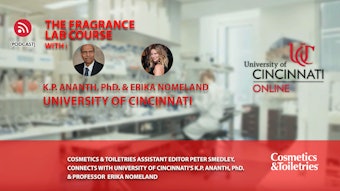Chemistry and Manufacture
Distearyldimethylammonium chloride or DSDMAC (INCI: Distearyldimonium Chloride) is a twin-tailed fatty quaternary ammonium organic compound or fatty quat (see Figure 1).1 The nitrogen atom is covalently bonded to two stearyl, i.e., n-octadecyl, groups and two methyl groups, and bears a positive charge that is balanced by a chloride anion. The molecular weight of DSDMAC (C38H80N•Cl) is 586.5 g/mol.
There are many possible synthetic pathways for the commercial preparation of DSDMAC,2–4 one of which begins with stearic acid (see Figure 2). Although fatty amines including those used to synthesize DSDMAC can be derived from a variety of commodity chemicals—i.e., fatty acids, fatty alcohols or alpha olefins, the typical precursor for DSDMAC is stearic acid, which is obtained from the hydrogenation and hydrolysis of triglycerides (fats and oils) from animal or plant sources and separation of the resulting fatty acids by distillation. Given the personal care industry’s preference for plant-derived ingredients, the stearic acid that is used to prepare cosmetic grade DSDMAC is typically obtained from nut or vegetable oils, e.g. palm, coconut, soy, etc.
In Figure 2, stearic acid is first condensed with ammonia (NH3) to liberate water and form the primary amide, stearamide, which is then catalytically dehydrated to yield stearonitrile. Following purification, this fatty nitrile is hydrogenated in the presence of excess NH3 to form the primary fatty amine stearamine. In the subsequent reaction, a different set of hydrogenation conditions is employed to reduce two equivalents of stearamine to the secondary amine, distearylamine, which simultaneously liberates an equivalent of NH3.
DSDMAC is finally formed via exhaustive alkylation of distearylamine with methyl chloride (CH3Cl) in the presence of sodium hydroxide (NaOH) to minimize formation of nonquaternary amine salts. This reaction is usually conducted in an alcohol solvent, such as isopropanol, and yields sodium chloride (NaCl) as a by-product. An important alternative route to the exhaustive alkylation with CH3Cl involves reductive amination of distearylamine via reaction with formaldehyde and hydrogen in the presence of a metal catalyst to form methyldistearylamine, followed by quaternization with CH3Cl to yield DSDMAC.4
Properties
DSDMAC is a waxy, white to off-white or yellowish solid that may be supplied as a powder or as pellets. Potential impurities in the raw material include residual solvent, e.g. isopropanol; NaCl; nonquaternary amines, e.g. methyldistearylamine; and HCl salts or amine oxides thereof. Although DSDMAC is mildly hydroscopic and typically contains up to 4% w/w water, the material is not water-soluble at room temperature. When heated to 48°C or higher, DSDMAC will form liquid crystalline (LC) solutions in water.5
Technology and Applications
Unlike most surfactants, DSDMAC has two very large hydrophobic tail groups bound to a single hydrophilic head group. This twin-tailed molecular architecture causes DSDMAC to possess a high critical packing parameter or P value. P describes the effective shape of surfactant molecules and is illustrated by Eq. 1:
Eq. 1 P = v /ao • lc
where v is the volume of the hydrophobic tail group, ao is the area of the hydrophilic head group, and lc is the length of the hydrophobic tail group.6 P values are rough indicators of the aggregate morphology that surfactants will form in aqueous solution. The complex solution behavior of DSDMAC in water, including its strong tendency to form complex LC phases, e.g. lamellar bilayers and vesicles,5, 7 is readily rationalized in terms of this concept.
Overall, DSDMAC is routinely employed as a cationic emulsifier in cosmetic formulations. It typically is formulated with fatty alcohols to yield o/w emulsions with lamellar LC structures for improved stability, aesthetics, moisturization and active delivery. Due to its cationic nature, DSDMAC is highly substantive to hair and skin, thus it is frequently used for hair and skin conditioning. For hair care, DSDMAC is employed as an anti-static agent and to improve the wet and dry combing properties of hair. It is generally formulated into rinse-out conditioners containing high levels of fatty alcohol, e.g. cetyl alcohol, although it has been added to shampoos as well.8 In skin care applications, emulsifier systems comprising DSDMAC and fatty alcohols can be used to prepare lotions and creams to deliver “heavy” emollients such as petrolatum without the feeling of greasy residue.9
O/W emulsions comprising DSDMAC can be prepared by either “one-pot” or two-phase processes. In the one-pot process, the emulsion is formed by dispersing the DSDMAC, fatty alcohols, specified emollients, and glycerin in water at 82–87°C with sufficient agitation to form a homogeneous mixture, which is then cooled by adding additional water with increasing agitation.9 The two-phase process involves heating an oil phase comprising DSDMAC, fatty alcohols and specified emollients to 75–80 °C, then dispersing it into an aqueous phase comprising water and humectants, e.g. glycerin, at the same temperature. Once formed, the o/w emulsion is homogenized until uniform and cooled under gentle stirring.10
Reproduction of the article without expressed consent is strictly prohibited.
References
Send e-mail to [email protected].
1. Distearyldimonium Chloride, Monograph ID 935, in the International Cosmetic Ingredient Dictionary and Handbook, 13th edn, Personal Care Products Council: Washington, USA (2010)
2. WM Linfield, Straight-chain alkyl ammonium compounds, ch 2 in Cationic Surfactants, Surfactant Science Series, vol. 4, E Jungermann, ed, Marcel Dekker, New York (1970) pp 9–70
3. K Visek, Amines, fatty, in Kirk-Othmer Encyclopedia of Chemical Technology, published online, John Wiley and Sons, Hoboken, NJ USA (Aug 15, 2003) pp 518–537
4. M Dery, Quaternary ammonium compounds, in Kirk-Othmer Encyclopedia of Chemical Technology, published online, John Wiley and Sons, Hoboken, NJ USA (Dec 4, 2000) pp 1–24
5. RG Laughlin, RL Munyon, YC Fu and AJ Fehl, Physical science of the dioctadecyldimethylammonium chloride-water system. 1. Equilibrium phase behavior, J Phys Chem 94 6 2546–2552 (1990)
6. R Nagarajan, Molecular packing parameter and surfactant self-assembly: The neglected role of the surfactant tail, Langmuir 18 1 31–38 (2002)
7. RG Laughlin, RL Munyon, JL Burns, TW Coffindaffer and Y Talmon, Physical science of the dioctadecyldimethylammonium chloride-water system. 3. Colloidal aspects, J Phys Chem 96 1 343–383 (1992)
8. US 2950255A, Detergent composition, SR Goff, assigned to The Gillette Co. (Aug 23, 1960)
9. US 4389418, Skin care composition, CK Burton, assigned to SC Johnson and Son, Inc. (Jun 21, 1983)
10. Varisoft TA 100 Product Bulletin, Evonik Goldschmidt GmbH: Essen, Germany (Sep 2009)










